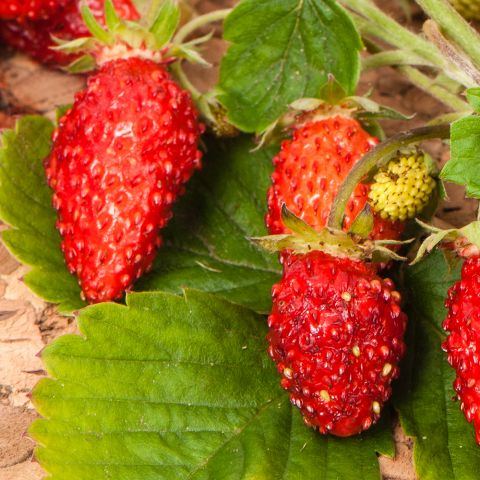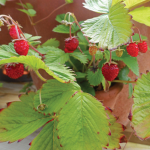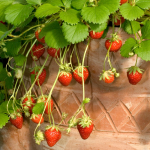Growing Strawberries
While Strawberry plants are relatively easy to grow, encouraging these perennials to produce abundant fruit each season and protecting ripe berries from pests, such as bugs, insects, and birds, can be a challenge. Still, there is something about the taste of ripe, succulent berries fresh from the garden that makes the extra challenge so worth it. Read on for everything you need to know—from selecting the right type of Strawberry plant for your region to planting, care, harvesting, and more—and enjoy success growing your own flavorful berries.
How to Select & Plant Strawberries
Strawberry Plant Varieties
The first step in successful Strawberry plant care is selecting the right cultivar for your region and needs. Strawberries can be grown outdoors in USDA Hardiness Zones 3–10. When selecting a Strawberry variety, ensure it is suited to your Zone.
Strawberry plants are classified into three primary groups based on their fruit production habits:
- June-Bearing Strawberry plants are the most common. These plants produce one large harvest of berries—usually in June—making them perfect for the gardener who likes to make jam or to cook with large quantities of berries. The plants multiply by sending out “runners,” so Strawberry patches need to be thinned and mowed each summer immediately after harvest to prevent overcrowding.
- Everbearing Strawberry plants generally produce two harvests each year—one in June, and another in early fall. While these plants send out runners, they should be pinched off and removed in order to encourage the main plant to grow larger and produce more fruit.
- Day-Neutral Strawberry plants are unique in that they rely on temperature, rather than length of day, to produce fruit. When temperatures are 40-80°, these plants may continue to flower and produce fruit, making them ideal for summer-long harvests in cooler regions. But in areas where the average summer temperature exceeds 80°, Day-Neutral Strawberries will follow fruiting patterns similar to Everbearing plants, with harvest periods in the spring and fall. And, just like Everbearing plants, Day-Neutral Strawberry plants should have their runners removed, as they can inhibit the main plant from growing and fruiting.
Consider how you will use your berries to determine the best type of Strawberry plant for your needs.
Planning Your Strawberry Patch
Strawberry plants are extremely versatile and well-suited to various growing styles. Gardeners with ample outdoor space may choose to grow Strawberries in traditional in-ground beds or raised garden beds, while those with limited space may prefer to grow them in containers on a deck or patio. Strawberries will even grow indoors in cooler climates and produce fresh berries in the winter. Growing methods for Strawberries include:
- In-Ground or Raised Beds – Strawberry plants can be placed in the ground in early spring when the soil has thawed. Select a location with well draining soil that receives at least 6 hours of sunlight each day, though 8 hours or more is preferred.
Avoid planting Strawberries where Potatoes, Tomatoes, Eggplants, or Peppers have been grown before. Soils in which these plants have grown may harbor the wilt-causing Verticillium fungus, which can harm your plants.
A soil pH of 6.5–6.8 is ideal, so test the soil and amend it as necessary before planting. Work compost into the soil to help fuel plant growth, or fill raised beds with a high-quality organic mix.
Depending on the Strawberry variety, plants should be spaced 12–24” apart. Those that produce runners require more space as they spread, while Alpine varieties, which are virtually runnerless, can be placed closer together.
To grow June-bearing Strawberries, position the plants 12–24” apart, allowing about 4’ between rows. Allow runners to spread and fill in the patch in a matted row system.
To grow Everbearing and Day-Neutral Strawberries, grow in a hill system by creating raised rows that are 8” tall, 24” wide, and as long as necessary for your space. Plant 2 staggered rows of plants in each hill, allowing 12” between plants. Place hills about 4’ apart. After planting, monitor growth and remove all runners immediately to focus all available energy on the main plants.
Apply a 2” layer of mulch around the plants to help with moisture retention while protecting the berries from dirt and pests.
- Containers – when using traditional cylindrical containers, calculate the planting surface area and plant no more than 3 Strawberry plants per square foot. When using a multi-pocket Strawberry jar, plant 1 plant in each pocket and no more than 3 plants in the top of the container.
Select a high-quality potting soil with excellent drainage—an organic mixture is preferred when growing produce. Apply a thin layer of mulch on top of the soil to help aid in moisture retention, cooling the soil, and protecting the berries from dirt and bugs.
Follow the care instructions for watering and fertilizing outlined below. If the plant produces runners, they can be trimmed and removed or replanted in their own containers.
In cold-winter climates, move the containers inside to a garage or cellar in the fall and keep them at 30–45ºF. Check the plants for moisture each week and water them just enough to keep the plants from drying out completely. Set the containers outside in the spring.
- Hanging Baskets – Strawberries can be easily grown in hanging baskets. Follow the planting and care instructions for growing in containers.
- Indoors – regardless of whether you grow them indoors or out, Strawberry plants require at least 6 hours of sunlight each day. Place your potted plants in a location where they receive enough sunlight, or supplement with an LED grow light. Follow the care instructions for watering and fertilizing outlined below.
Once the plants flower, they will need hand pollinating to produce fruit. Use a paintbrush or cotton swab to gently pick up pollen from the outer portion of the flower’s center and deposit it on the innermost portion.
If the plant produces any runners, trim them back and replant or discard them.
Planting Strawberries
If you purchase bare root plants, take care to set them at the proper depth. Identify the crown—the point where the stem and roots meet—and set it precisely at soil level to keep the plant from rotting or drying out. Spread the roots evenly inside the hole, and then gently cover them with soil and water thoroughly.
If you purchase potted plants, dig a hole large enough to fit the root ball and plant the Strawberries at the same depth as their nursery pot. Ideally, this will be to the point where the stem and roots meet, so the soil is just covering the tops of the roots without covering the crown. Placing the crown precisely at soil level--rather than deeper or higher--is very important. It keeps the crown from rotting or from drying out. Plant on a cloudy day or in the late afternoon.
How to Grow Strawberries
Light: Strawberries require full sunlight in order to thrive. While they can survive with 6 hours of direct sunlight, 8–10 hours is ideal. Increased exposure to sunlight will help boost fruit production and improve berry quality.
Watering: Strawberry plants require about 1–2” of water each week. Never let the plants dry out completely, as this can halt flower and berry production and may harm or kill the plant. Avoid wetting the leaves when possible and never water plants at night, as this can lead to disease.
When grown in pots—particularly in clay or terracotta—Strawberry plants require more frequent watering. Check the soil every few days and water the plants thoroughly whenever the top 1” of soil feels dry to the touch. Allow excess moisture to drain away from the plant after each watering to prevent rot. Pay extra attention to watering Strawberry jars to ensure the water consistently reaches each pocket/plant.
Fertilizing: Never fertilize Strawberries immediately after planting them—always wait until first fruits have formed to fertilize a new Strawberry Plant.
Established June-Bearing plants should be fertilized in early spring and again in the summer after berries have begun to form or when renovating (see below). Fertilize established Everbearing and Day-Neutral Strawberries monthly during the growing season. Use a balanced fertilizer—take care to keep the fertilizer from coming into contact with the plants’ leaves and berries, as this can scorch them.
Pruning: Well-established Strawberry plants will produce more abundant berry harvests. To help new plants become established, remove all flower buds from your plants until late June while you may not get any berries the first year, you’ll have better berry harvests in subsequent years.
Most popular varieties of Strawberry plants produce runners, which are horizontal stems that grow along the surface of the soil and produce new plants. While this habit can add more berry-producing plants to the patch, some varieties grow and fruit better when the runners are pinched back.
For June-Bearing varieties, allow the plants to produce runners, but train them into specific patterns or prune as needed to ensure the plants have adequate space to grow. If the runners become too crowded, the plants will produce fewer berries.
For Everbearing and Day-Neutral Strawberries, prune all runners until July of the first year. After that, you may choose to prune all runners or allow the plants to send out only 1–2 runners each. If these varieties produce too many runners, they will divert their energy to the new plants and produce fewer berries.
Harvesting Berries: Harvest berries whenever they are deep red—strawberries do not continue to ripen after you pick them, so allow them to remain on the plant until they are fully ripe. To harvest berries, use your fingernails or garden shears to gently cut the stem just above the berry. The best time of day to harvest berries is in the morning, after the dew has dried. Store them in a cool, dry place or refrigerate them.
Depending on which type of Strawberry plant you grow, you may have only one harvest in June, a second harvest in late summer, or a continual harvest throughout the growing season. Do not allow berries to over ripen on the plant, as this can attract bugs and pests.
Renovating Strawberry Patches: Strawberry patches with June-Bearing plants should be renovated each year. As soon as the harvest is complete, cut foliage off just above the crown, and then till or hoe both sides of each row a week or so later to reduce the row width to about 1′. Remove excess plants to achieve a spacing of 3–5″ between plants, and apply a balanced, timed-release fertilizer. This will help keep the bed healthy and disrupt pests that try to grow on the plants.
Pests and Diseases: Birds are particularly fond of strawberries and may try to compete for your hard-earned harvest. To protect your plants, place a mesh cover over them as soon as berries begin to appear. Ensure that the mesh is large enough to allow bees and other pollinators to access your plants, or they will not produce fruit.
If slugs are an issue, set slug traps, use slug bait, or apply a layer of diatomaceous earth to protect your berries.
Overwintering: These hardy perennials can produce yields for many years. For June-Bearing varieties, follow the instructions above for renovating your plants. In colder climates, wait until early winter when temperatures drop and the soil begins to freeze, and then apply 4-6” of light insulating material such as straw, with a lighter layer on top of the plants themselves. In the spring—about the time the Daffodils bloom—rake away the mulch to allow the plants to begin growing again. Note that the buds are sensitive to frost, so take care to protect plants from early-spring frosts by re-applying mulch or covering them with blankets.
When growing Strawberries in containers, move them inside to an unheated shed or garage in the fall. Check the plants for moisture each week and add just enough water to keep them from drying out completely. Set the containers outside in the spring.
Strawberry Growing Tips
To Grow Big Strawberries, prune all runners and half of the flowers. While this will reduce the total number of berries produced, it will increase the size of the berries.
To Grow Sweet Strawberries, ensure that the plants have appropriate soil, water, and sunlight conditions as outlined above. Allow berries to fully ripen on the plant and harvest them in the morning for the sweetest taste.
The Best Companion Plants for Strawberries include alliums and herbs that help repel pests, leafy greens that help protect the berries from birds, and pollinator-friendly flowers that attract bees and other pollinators to your Strawberry patch.
Frequently Asked Questions
Where do Strawberry plants grow?
With dozens of varieties available, Strawberries will grow in most regions across the continental US. Strawberries are hardy in Zones 3–10.
How long does it take for Strawberries to grow?
Strawberry plants can produce fruit during their first growing season, though pinching back blooms the first year will encourage better harvests in subsequent years. Established plants will produce berries within 4–6 weeks after flowers form. Depending on the variety, Strawberries may produce fruit harvests once per year in June, twice per year in June and early autumn, or continually throughout the summer.
When is the best time to grow Strawberries?
The best time to plant strawberries is after the last frost in spring. Though the plants can withstand frost, it can damage the delicate flowers and prevent the plant from forming berries.





